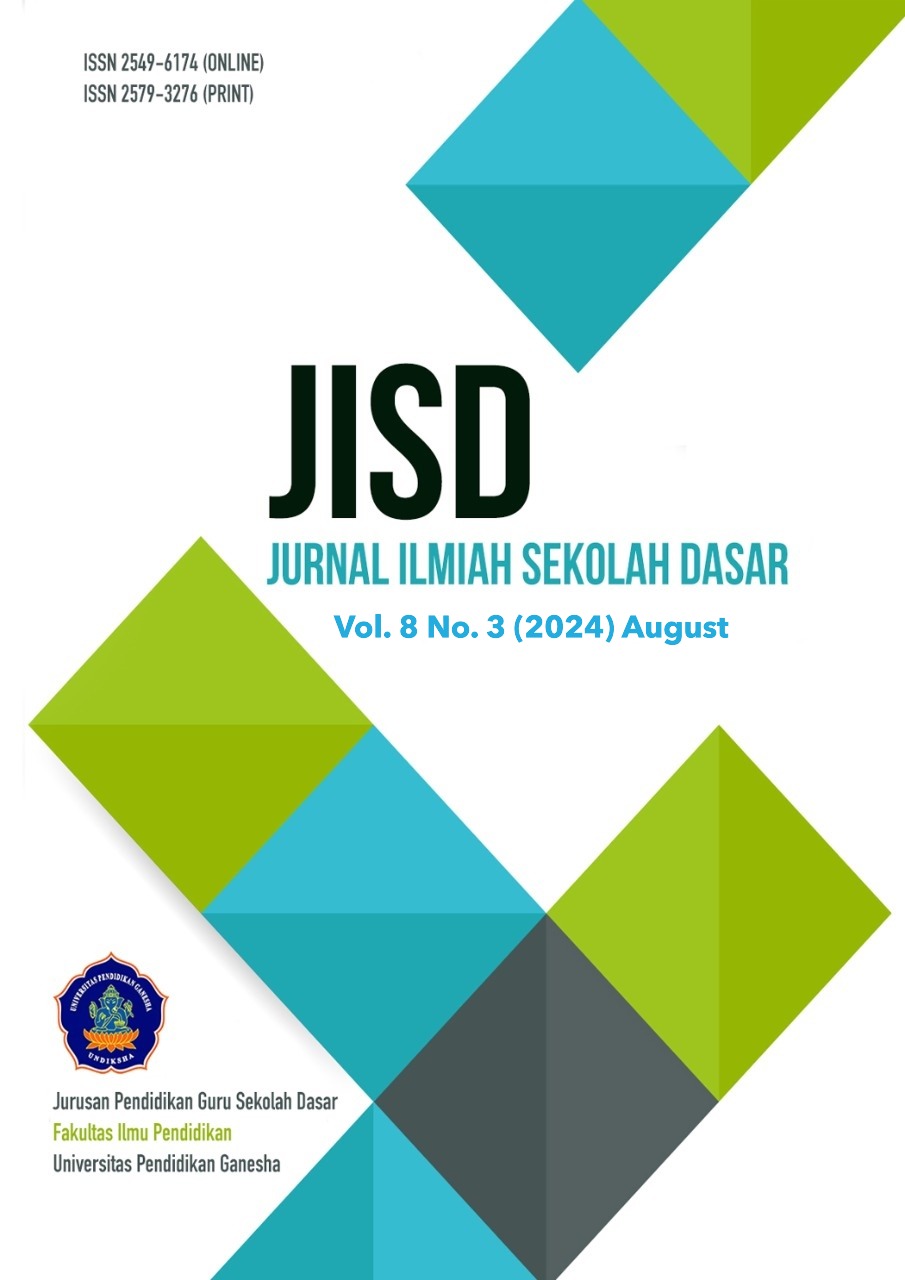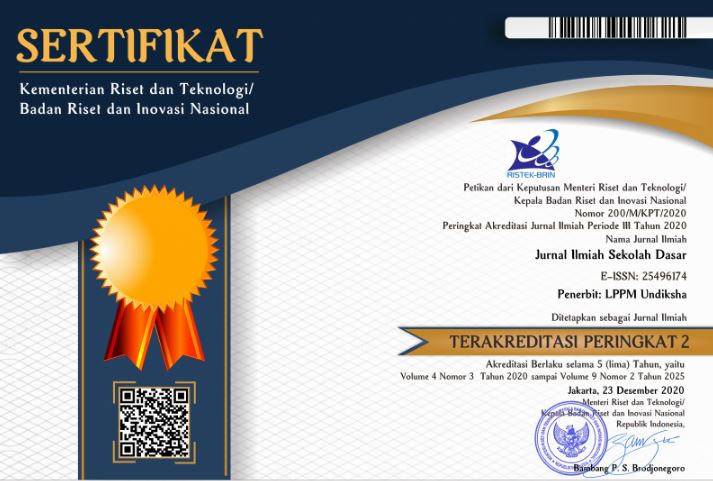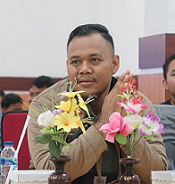Validating Educational Game Development to Foster Learning Motivation in Elementary School Students
DOI:
https://doi.org/10.23887/jisd.v8i3.62657Keywords:
Media, Educational Game, Student’s Activity, Learning MotivationAbstract
One of the causes of low student learning motivation is the lack of engaging and need-based instructional media developed by teachers for specific subjects. Educational games can foster intrinsic motivation by stimulating students' curiosity, thereby supporting the teaching and learning process in formal educational environments. This study aims to analyze the validity of an educational game developed to enhance students' learning motivation through a validity test. The development process employed the Research and Development (R&D) model recommended by Borg and Gall. Data collection instruments included validation sheets from media, material, and language experts, a media usage guidebook, observation guidelines for media implementation in learning, interview guidelines for teachers and students, and a student motivation instrument. The data analysis technique used was descriptive quantitative analysis. The validity test results indicated that the media's validity level was categorized as good. The product quality category from the instrument experts showed a score of 0.785. Since the Cronbach's Alpha value was 0.785, which is greater than 0.60, it can be concluded that the reliability test was deemed reliable. Therefore, the educational game developed is considered feasible and effective for improving students' learning motivation in elementary schools.
References
Acquah, E. O., & Katz, H. T. (2020). Digital game-based L2 learning outcomes for primary through high-school students: A systematic literature review. Computers and Education, 143. https://doi.org/10.1016/j.compedu.2019.103667.
Akerson, V. L., Carter, I., Pongsanon, K., & Nargund-Joshi, V. (2019). Teaching and Learning Nature of Science in Elementary Classrooms. Science & Education, 28(3–5), 391–411.
https://doi.org/10.1007/s11191-019-00045-1.
Al-Ansi, A. M., Jaboob, M., Garad, A., & Al-Ansi, A. (2023). Analyzing augmented reality (AR) and virtual reality (VR) recent development in education. Social Sciences & Humanities Open, 8(1), 100532. https://doi.org/10.1016/j.ssaho.2023.100532.
Al-Zou’bi, R. (2021). The impact of media and information literacy on acquiring the critical thinking skill by the educational faculty’s students. Thinking Skills and Creativity, 39.
https://doi.org/10.1016/j.tsc.2020.100782.
Albahiri, M. H., & Alhaj, A. A. M. (2020). Role of visual element in spoken English discourse: implications for YouTube technology in EFL classrooms. The Electronic Library, 38(3), 531–544. https://doi.org/10.1108/EL-07-2019-0172.
Amrulloh, T. R., Risnasari, M., & Ningsih, P. R. (2019). Pengembangan game edukasi matematika (operasi bilangan pecahan) berbasis android untuk Sekolah Dasar. Jurnal Ilmiah Edutic: Pendidikan Dan Informatika, 5(2), 115–123. https://journal.trunojoyo.ac.id/edutic/article/view/5355/0.
Ardoin, N. M., & Heimlich, J. E. (2021). Environmental learning in everyday life: foundations of meaning and a context for change. Environmental Education Research, 27(12), 1681–1699.
https://doi.org/10.1080/13504622.2021.1992354.
Babakr, Z., Mohamedamin, P., & Kakamad, K. (2019). Piaget’s cognitive developmental theory: Critical review. Education Quarterly Reviews, 2(3).
https://papers.ssrn.com/sol3/papers.cfm?abstract_id=3437574.
Bakhtiar, A., & Hadwin, A. F. (2022). Motivation From a Self-Regulated Learning Perspective: Application to School Psychology. Canadian Journal of School Psychology, 37(1), 93–116.
https://doi.org/10.1177/08295735211054699.
Börnert-Ringleb, M., & Wilbert, J. (2018). The Association of Strategy Use and Concrete-Operational Thinking in Primary School. Frontiers in Education, 3. https://doi.org/10.3389/feduc.2018.00038.
Broom, C. (2015). Empowering students: Pedagogy that benefits educators and learners. Citizenship, Social and Economics Education, 14(2), 79–86. https://doi.org/10.1177/2047173415597142.
Bryce, T. G. K., & Blown, E. J. (2023). Ausubel’s meaningful learning re-visited. Current Psychology. https://doi.org/10.1007/s12144-023-04440-4.
Cassidy, C., Marwick, H., Dwyer, C., & Lucas, E. (2022). Creating a learning environment conducive to children’s well-being through philosophy with children in a Scottish classroom. Education 3-13, 1–13. https://doi.org/10.1080/03004279.2022.2125333.
Cents-Boonstra, M., Lichtwarck-Aschoff, A., Denessen, E., Aelterman, N., & Haerens, L. (2021). Fostering student engagement with motivating teaching: an observation study of teacher and student behaviours. Research Papers in Education, 36(6), 754–779.
https://doi.org/10.1080/02671522.2020.1767184.
Chan-anteza, T. K. (2020). Management of a Conducive Classroom Environment: A Meta-synthesis. Journal of Education and Practice, 11(26), 54–70. https://doi.org/10.7176/jep/11-26-06.
Curran, F. C., & Kitchin, J. (2019). Early Elementary Science Instruction: Does More Time on Science or Science Topics/Skills Predict Science Achievement in the Early Grades? AERA Open, 5(3), 233285841986108. https://doi.org/10.1177/2332858419861081.
Desoete, A., & De Craene, B. (2019). Metacognition and mathematics education: an overview. ZDM, 51(4), 565–575. https://doi.org/10.1007/s11858-019-01060-w.
DiNapoli, J., & Miller, E. K. (2022). Recognizing, supporting, and improving student perseverance in mathematical problem-solving: The role of conceptual thinking scaffolds. The Journal of Mathematical Behavior, 66, 100965. https://doi.org/10.1016/j.jmathb.2022.100965.
Eccles, J. S., & Wigfield, A. (2020). From expectancy-value theory to situated expectancy-value theory: A developmental, social cognitive, and sociocultural perspective on motivation. Contemporary Educational Psychology, 61, 101859. https://doi.org/10.1016/j.cedpsych.2020.101859.
Eltahir, M. E., Alsalhi, N. R., Al-Qatawneh, S., AlQudah, H. A., & Jaradat, M. (2021). The impact of game-based learning (GBL) on students’ motivation, engagement and academic performance on an Arabic language grammar course in higher education. Education and Information Technologies, 26(3), 3251–3278. https://doi.org/10.1007/s10639-020-10396-w.
Filgona, J., Sakiyo, J., Gwany, D. M., & Okoronka, A. U. (2020). Motivation in Learning. Asian Journal of Education and Social Studies, 16–37. https://doi.org/10.9734/ajess/2020/v10i430273.
Fredricks, J. A., Blumenfeld, P. C., & Paris, A. H. (2004). School Engagement: Potential of the Concept, State of the Evidence. Review of Educational Research, 74(1), 59–109.
https://doi.org/10.3102/00346543074001059.
Frenzel, A. C., Daniels, L., & Burić, I. (2021). Teacher emotions in the classroom and their implications for students. Educational Psychologist, 56(4), 250–264.
https://doi.org/10.1080/00461520.2021.1985501.
Gibson, J. L., Pritchard, E., & de Lemos, C. (2021). Play-based interventions to support social and communication development in autistic children aged 2–8 years: A scoping review. Autism & Developmental Language Impairments, 6, 239694152110158.
https://doi.org/10.1177/23969415211015840.
Hallifax, S., Lavoué, E., & Serna, A. (2020). To Tailor or Not to Tailor Gamification? An Analysis of the Impact of Tailored Game Elements on Learners’ Behaviours and Motivation (pp. 216–227). https://doi.org/10.1007/978-3-030-52237-7_18.
Harackiewicz, J. M., Smith, J. L., & Priniski, S. J. (2016). Interest Matters: The Importance of Promoting Interest in Education. Policy Insights from the Behavioral and Brain Sciences, 3(2), 220–227. https://doi.org/10.1177/2372732216655542.
Hartmann, A., & Gommer, L. (2021). To play or not to play: on the motivational effects of games in engineering education. European Journal of Engineering Education, 46(3), 319–343. https://doi.org/10.1080/03043797.2019.1690430.
Hartt, M., Hosseini, H., & Mostafapour, M. (2020). Game On: Exploring the Effectiveness of Game-based Learning. Planning Practice & Research, 35(5), 589–604.
https://doi.org/10.1080/02697459.2020.1778859.
Heyder, A., Weidinger, A. F., Cimpian, A., & Steinmayr, R. (2020). Teachers’ belief that math requires innate ability predicts lower intrinsic motivation among low-achieving students. Learning and Instruction, 65, 101220. https://doi.org/10.1016/j.learninstruc.2019.101220.
Jiang, S., Simpkins, S. D., & Eccles, J. S. (2020). Individuals’ math and science motivation and their subsequent STEM choices and achievement in high school and college: A longitudinal study of gender and college generation status differences. Developmental Psychology, 56(11), 2137.
https://doi.org/10.1037/dev0001110.
Kalogiannakis, M., Papadakis, S., & Zourmpakis, A. I. (2021). Gamification in science education. A systematic review of the literature. Education Sciences, 11(1), 1–36.
https://doi.org/10.3390/educsci11010022.
Karimi, S., & Sotoodeh, B. (2020). The mediating role of intrinsic motivation in the relationship between basic psychological needs satisfaction and academic engagement in agriculture students. Teaching in Higher Education, 25(8), 959–975. https://doi.org/10.1080/13562517.2019.1623775.
Krath, J., Schürmann, L., & von Korflesch, H. F. O. (2021). Revealing the theoretical basis of gamification: A systematic review and analysis of theory in research on gamification, serious games and game-based learning. Computers in Human Behavior, 125, 106963.
https://doi.org/10.1016/j.chb.2021.106963.
Lazarides, R., Dietrich, J., & Taskinen, P. H. (2019). Stability and change in students’ motivational profiles in mathematics classrooms: The role of perceived teaching. Teaching and Teacher Education, 79, 164–175. https://doi.org/10.1016/j.tate.2018.12.016.
Lu, S.-J., Liu, Y.-C., Chen, P.-J., & Hsieh, M.-R. (2020). Evaluation of AR embedded physical puzzle game on students’ learning achievement and motivation on elementary natural science. Interactive Learning Environments, 28(4), 451–463. https://doi.org/10.1080/10494820.2018.1541908.
Ma’dan, M., Ismail, M. T., & Daud, S. (2020). Strategies To Enhance Graduate Employability: Insights From Malaysian Public University Policy-Makers. Malaysian Journal of Learning and Instruction, 17(Number 2), 137–165. https://doi.org/10.32890/mjli2020.17.2.5.
Marpanaji, E., Mahali, M. I., & Putra, R. A. S. (2018). Survey on how to select and develop learning media conducted by teacher professional education participants. In Journal of Physics: Conference Series, 1140. https://doi.org/10.1088/1742-6596/1140/1/012014.
Micallef, A., & Newton, P. M. (2024). The Use of Concrete Examples Enhances the Learning of Abstract Concepts: A Replication Study. Teaching of Psychology, 51(1), 22–29.
https://doi.org/10.1177/00986283211058069.
Mikropoulos, T. A., & Papachristos, N. M. (2021). SciLOET: A Framework for Assessing Digital Learning Objects for Science Education (pp. 340–348). https://doi.org/10.1007/978-3-030-73988-1_27.
Monica, H., Kesumawati, N., & Septiati, E. (2019). Pengaruh Model Problem Based Learning Terhadap Kemampuan Pemecahan Masalah Matematis dan Keyakinan Matematis Siswa. MaPan (Jurnal Matematika Dan Pembelajaran), 7(1), 155–166. https://doi.org/10.24252/mapan.2019v7n1a12.
Moyer-Packenham, P. S., Lommatsch, C. W., Litster, K., Ashby, J., Bullock, E. K., Roxburgh, A. L., Shumway, J. F., Speed, E., Covington, B., Hartmann, C., Clarke-Midura, J., Skaria, J., Westenskow, A., MacDonald, B., Symanzik, J., & Jordan, K. (2019). How design features in digital math games support learning and mathematics connections. Computers in Human Behavior, 91, 316–332.
https://doi.org/10.1016/j.chb.2018.09.036.
Nicolaou, C., Matsiola, M., & Kalliris, G. (2019). Technology-enhanced learning and teaching methodologies through audiovisual media. Education Sciences, 9(3). https://doi.org/10.3390/educsci9030196.
Niles, D., & Tachimoto, N. (2018). Science and the experience of nature. Nature Sustainability, 1(10), 540–543. https://doi.org/10.1038/s41893-018-0124-y.
Othaman, S., Shamshuddin, M. H., Samah, M., & Aziz, N. (2017). The use of concrete material in teaching and learning mathematics. Journal of Engineering and Applied Sciences, 12(8), 2170–2174. https://journal.trunojoyo.ac.id/edutic/article/view/5355/0.
Partovi, T., & Razavi, M. R. (2019). The effect of game-based learning on academic achievement motivation of elementary school students. Learning and Motivation, 68, 101592.
https://doi.org/10.1016/j.lmot.2019.101592.
Pellas, N., Fotaris, P., Kazanidis, I., & Wells, D. (2019). Augmenting the learning experience in primary and secondary school education: a systematic review of recent trends in augmented reality game-based learning. Virtual Reality, 23(4), 329–346. https://doi.org/10.1007/s10055-018-0347-2.
Pettersson, F. (2018). On the issues of digital competence in educational contexts–a review of literature. Education and Information Technologies, 23(3), 1005–1021.
https://link.springer.com/article/10.1007/s10639-017-9649-3.
Portuguez Castro, M., Ross Scheede, C., & Gómez Zermeño, M. G. (2019). The Impact of Higher Education on Entrepreneurship and the Innovation Ecosystem: A Case Study in Mexico. Sustainability, 11(20), 5597. https://doi.org/10.3390/su11205597.
Purwati, E., & Akmaliyah, M. (2016). Hubungan antara Self Efficacy dengan Flow Akademik pada Siswa Akselerasi SMPN 1 Sidoarjo. Psympathic : Jurnal Ilmiah Psikologi, 3(2), 249–260.
https://doi.org/10.15575/psy.v3i2.1113.
Ramey, K. E., & Stevens, R. (2023). Dilemmas experienced by teachers in adapting to the role of facilitator in the STEAM classroom. Teaching and Teacher Education, 133, 104271.
https://doi.org/10.1016/j.tate.2023.104271.
Ryan, R. M., & Deci, E. L. (2020). Intrinsic and extrinsic motivation from a self-determination theory perspective: Definitions, theory, practices, and future directions. Contemporary Educational Psychology, 61, 101860. https://doi.org/10.1016/j.cedpsych.2020.101860.
Salhab, R., & Daher, W. (2023). University Students’ Engagement in Mobile Learning. European Journal of Investigation in Health, Psychology and Education, 13(1), 202–216.
https://doi.org/10.3390/ejihpe13010016.
Seng, L. C. (2018). Malaysia Public Universities’ Graduate Employability Policies: An Analysis of First Degree Graduates Unemployment and Underemployment Issues. Print) International Journal of Social Science and Humanities Research, 6(4), 480–489.
Suharsimi Arikunto. (2021). Dasar-Dasar Evaluasi Pendidikan Edisi 3 (Restu Damayanti (ed.); Ketiga). PT Bumi Aksara.
Supriatna, U., Samsudin, A., & Efendi, R. (2019). Teaching Solar System Topic through Predict-Observe-Explain-Apply (POEA) Strategy: A Path to Students’ Conceptual Change. Tadris: Jurnal Keguruan Dan Ilmu Tarbiyah, 4(1), 1–15. https://doi.org/10.24042/tadris.v4i1.3658.
Ulfah, S. M., Sururi, S., & Amrullah, S. (2020). Strategy in Improving the Quality of Vocational High School Graduates. Proceedings of the 3rd International Conference on Research of Educational Administration and Management (ICREAM 2019). https://doi.org/10.2991/assehr.k.200130.162.
Vincent-Ruz, P., & Schunn, C. D. (2018). The nature of science identity and its role as the driver of student choices. International Journal of STEM Education, 5(1), 48. https://doi.org/10.1186/s40594-018-0140-5.
Wahyuni, S. T., & Yuliana, L. (2023). The Strategy to Improve the Quality of Vocational School Graduates Through Partnership Program (pp. 255–260). https://doi.org/10.2991/978-2-38476-034-3_32.
Wicaksono, A. G., & Rahman, I. H. (2022). Philosophy of Integrated Natural Science Learning. Jurnal Pena Sains, 9(2), 28–35. https://doi.org/10.21107/jps.v9i2.16778.
Wilkinson, L. C., Bailey, A. L., & Maher, C. A. (2018). Students’ Mathematical Reasoning, Communication, and Language Representations: A Video-Narrative Analysis. ECNU Review of Education, 1(3), 1–22. https://doi.org/10.30926/ecnuroe2018010301.
Wu, Y. J., Goh, M., & Mai, Y. (2023). Social innovation and higher education: evolution and future promise. Humanities and Social Sciences Communications, 10(1), 283. https://doi.org/10.1057/s41599-023-01759-y.
Xu, B., Chen, N.-S., & Chen, G. (2020). Effects of teacher role on student engagement in WeChat-Based online discussion learning. Computers & Education, 157, 103956.
https://www.sciencedirect.com/science/article/pii/S0360131520301548.
Yang, L., Chiu, M. M., & Yan, Z. (2021). The power of teacher feedback in affecting student learning and achievement: insights from students’ perspective. Educational Psychology, 41(7), 821–824. https://doi.org/10.1080/01443410.2021.1964855.
Yang, X., Zhang, M., Kong, L., Wang, Q., & Hong, J. C. (2021). The Effects of Scientific Self-efficacy and Cognitive Anxiety on Science Engagement with the “Question-Observation-Doing-Explanation” Model during School Disruption in COVID-19 Pandemic. Journal of Science Education and Technology, 30(3), 380–393. https://doi.org/10.1007/s10956-020-09877-x.
Yeh, Y., Chang, J.-Y., & Ting, Y.-S. (2023). Engaging Elementary School Children in Mindful Learning Through Story-Based Creativity Games Facilitates Their Growth Mindset. International Journal of Human–Computer Interaction, 39(3), 519–528. https://doi.org/10.1080/10447318.2022.2041901.
Yu, Z., Gao, M., & Wang, L. (2021). The Effect of Educational Games on Learning Outcomes, Student Motivation, Engagement and Satisfaction. Journal of Educational Computing Research, 59(3), 522–546. https://doi.org/10.1177/0735633120969214.
Zahara, A., Feranie, S., Winarno, N., & Siswontoro, N. (2020). Discovery Learning with the Solar System Scope Application to Enhance Learning in Middle School Students. Journal of Science Learning, 3(3), 174–184. https://doi.org/10.17509/jsl.v3i3.23503.
Zajda, J. (2018). Globalisation and education reforms: Paradigms and ideologies. Springer.
Downloads
Published
How to Cite
Issue
Section
License
Copyright (c) 2024 Shofie Putriningtyas, Unik Ambarwati

This work is licensed under a Creative Commons Attribution-ShareAlike 4.0 International License.
Authors who publish with the Journal Ilmiah Sekolah Dasar agree to the following terms:
- Authors retain copyright and grant the journal the right of first publication with the work simultaneously licensed under a Creative Commons Attribution License (CC BY-SA 4.0) that allows others to share the work with an acknowledgment of the work's authorship and initial publication in this journal.
- Authors are able to enter into separate, additional contractual arrangements for the non-exclusive distribution of the journal's published version of the work (e.g., post it to an institutional repository or publish it in a book), with an acknowledgment of its initial publication in this journal.
- Authors are permitted and encouraged to post their work online (e.g., in institutional repositories or on their website) prior to and during the submission process, as it can lead to productive exchanges, as well as earlier and greater citation of published work. (See The Effect of Open Access)










